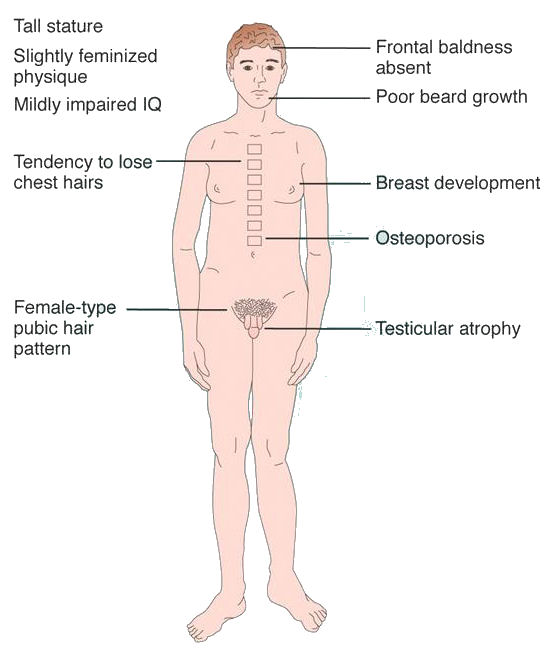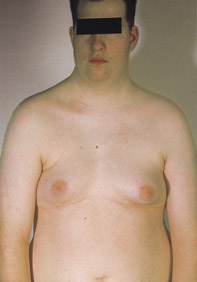


Tony rare 2n = 48,XXYY form
Klinefelter Syndrome (2n = 47, XXY)
Klinefelter Syndrome is
the most
common chromosomal syndrome, and occurs in about 1 in 500 live
births.
The basic male phenotype is set by the Y
chromosome: duplication of the X
chromosome genes often contributes to a
hormonal makeup (hypogonadism) intermediate between XX females and XY males. XXY individuals
often have a low
serum testosterone level, high serum follicle-stimulating
hormone (FSH), and
luteinizing hormone (LH)
levels. XXY men often have microorchidism
(small testicles) and are typically infertile. Physical characteristics vary
widely, from
a tall,
thin, youthful or
somewhat feminized physique
and facial appearance, to a shorter, rounded body type. Secondary sex-characteristics such
as
pubic hair patterns are often feminized, and there is often some degree of gynecomastia (female-type breast development),
with a
significantly higher risk of breast cancer.
As with Turner Syndrome (XO
females), there is a range of intellectual developmental, with
specific psychological impairments including language ability
and
deficits in executive functions. Social stigmatization is a
problem.
There is apparently no increased tendency to homosexuality.
As with other chromosomal syndromes, the standard 'syndrome' may reflect in part to ascertainment bias: XXY males are often diagnosed as such only when they present with overt physical characteristics, whereas other XXY individuals are asymptomatic. Tony [left] worked as a computer programmer, married, and was identified as XXY only when the couple sought infertility counseling. He shows an atypical baldness pattern often associated with XYY. The man on the right, with a rarer XXYY karyotype, shows uncorrected gynecomastia.
As with other chromosomal syndromes, the standard 'syndrome' may reflect in part to ascertainment bias: XXY males are often diagnosed as such only when they present with overt physical characteristics, whereas other XXY individuals are asymptomatic. Tony [left] worked as a computer programmer, married, and was identified as XXY only when the couple sought infertility counseling. He shows an atypical baldness pattern often associated with XYY. The man on the right, with a rarer XXYY karyotype, shows uncorrected gynecomastia.